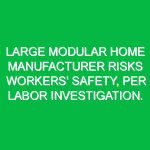The oil and gas industry, a cornerstone of the global economy, is fraught with occupational health hazards that pose significant risks to its workforce. Navigating these hazards requires a comprehensive understanding of the risks involved and the implementation of effective health, safety, and environment (HSE) strategies. This article delves into the myriad of occupational health hazards present in the oil and gas sector, offering insights and guidance on how to mitigate these risks and ensure a safer working environment.
The Landscape of Occupational Health Hazards in Oil and Gas
The oil and gas industry is inherently hazardous. Workers are exposed to a variety of risks ranging from chemical exposures to physical injuries. Understanding these risks is the first step in mitigating them.
Chemical Exposures
One of the most significant health hazards in the oil and gas industry is exposure to hazardous chemicals. These can include hydrocarbons, hydrogen sulfide, mercury, and benzene, among others. Prolonged exposure to these chemicals can lead to serious health issues, including respiratory problems, skin disorders, and even cancer.
Physical Hazards
Besides chemical risks, workers in the oil and gas sector are also exposed to numerous physical hazards. These include, but are not limited to, noise, vibration, extreme temperatures, and ergonomic challenges. Physical injuries can result from falls, equipment malfunctions, and explosions, which are not uncommon in this high-stakes industry.
Strategies for Mitigating Health Hazards
To navigate the occupational health hazards in the oil and gas industry, companies must implement robust HSE strategies. These strategies should be comprehensive, covering all aspects of health and safety, from risk assessment to emergency response.
Implementing Effective HSE Policies
Developing and enforcing effective HSE policies is crucial. These policies should be based on thorough risk assessments and comply with local and international health and safety regulations. Training employees on these policies and the proper use of safety equipment is equally important.
Regular Health Monitoring and Surveillance
Regular health monitoring and surveillance of workers can help in early detection of health issues related to occupational hazards. This includes regular medical check-ups, monitoring of exposure levels, and providing appropriate personal protective equipment (PPE).
Emergency Preparedness and Response
Despite all preventive measures, emergencies can still occur. Therefore, having a well-prepared emergency response plan is essential. This plan should include procedures for dealing with chemical spills, fires, and medical emergencies, ensuring the safety and health of all employees.
Technological Advances in HSE
The integration of technology into HSE practices offers new avenues for enhancing safety in the oil and gas industry. Innovations such as wearable technology for monitoring workers’ health, drones for inspecting hard-to-reach areas, and advanced data analytics for risk assessment are transforming the way companies approach occupational health hazards.
Wearable Technology
Wearable technology can monitor vital signs and environmental conditions, providing real-time data that can help prevent health issues before they occur. This technology can alert workers and management to potential hazards, such as exposure to toxic gases or extreme temperatures.
Drones and Robotics
Drones and robotics are being increasingly used for inspections and maintenance tasks in hazardous environments. By reducing the need for human presence in these areas, they significantly lower the risk of accidents and exposure to harmful substances.
Data Analytics and AI
Advanced data analytics and artificial intelligence (AI) can analyze vast amounts of data to identify patterns and predict potential hazards. This predictive capability can be instrumental in preventing accidents and occupational health issues.
Creating a Culture of Safety
Beyond implementing policies and leveraging technology, creating a culture of safety is paramount. This involves fostering an environment where safety is everyone’s responsibility, and where workers feel empowered to report hazards and participate in safety initiatives.
Training and Awareness
Continuous training and awareness programs are essential to keep workers informed about the latest safety practices and technologies. These programs should also emphasize the importance of personal responsibility in maintaining a safe working environment.
Employee Engagement
Engaging employees in safety discussions and decision-making processes can lead to more effective safety practices. Workers who feel involved are more likely to adhere to safety protocols and contribute to a safer workplace.
Conclusion: Navigating the Path to Safety
The oil and gas industry faces significant occupational health hazards, but with the right strategies, these risks can be mitigated. By implementing effective HSE policies, leveraging technology, and fostering a culture of safety, companies can protect their workers and ensure a safer working environment. Remember, safety in the oil and gas industry is not just about compliance; it’s about creating a workplace where every employee returns home safely at the end of the day.
Summary of Key Points
- Occupational health hazards in the oil and gas industry range from chemical exposures to physical injuries.
- Effective HSE strategies, including policies, training, and regular health monitoring, are crucial for mitigating these risks.
- Technological advances, such as wearable technology, drones, and data analytics, offer new ways to enhance safety.
- Creating a culture of safety, through training, awareness, and employee engagement, is essential for a safer workplace.
By understanding and addressing the occupational health hazards in the oil and gas industry, we can navigate the path to a safer and healthier working environment for all.


